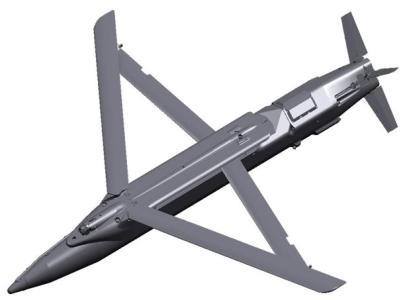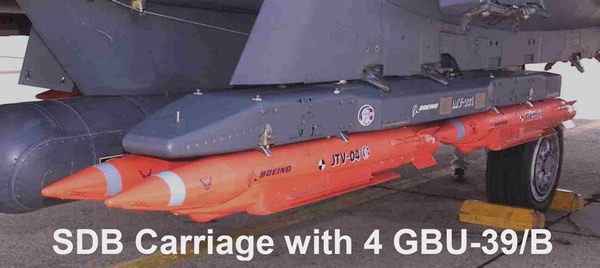Boeing / Lockheed Martin SDB (Small Diameter Bomb)
(GBU-39/B, GBU-40/B, GBU-41/B, GBU-42/B, GBU-53/B)
In the 1995/96 time frame, the U.S. Air Force conducted the MMTD (Miniaturized Munitions Technology Demonstration) research program to evaluate technologies for a new small (250 lb class) multi-purpose precision guided stand-off bomb. This was followed in 1998 by the establishment of the SBS (Small Bomb System) program, which was to cover the development of an operational weapon. SBS was renamed to SSB (Small Smart Bomb), and finally to SDB (Small Diameter Bomb). The SDB development was divided into two phases:
- Phase I for a weapon against stationary targets, using GPS-aided inertial guidance (like JDAM (Joint Direct Attack Munition)).
- Phase II (a.k.a. SDB II or "SDB Increment II") for the addition of a terminal seeker for engagement of moving targets.
In September 2001, contracts were awarded to Boeing and Lockheed Martin for the competitive development of an SDB design. The designations GBU-39/B through -42/B were assigned as follows:
| Contractor | SDB Phase I | SDB Phase II |
|---|---|---|
| Boeing | GBU-39/B | GBU-40/B |
| Lockheed Martin | GBU-41/B | GBU-42/B |
In May 2002, the USAF deferred Phase II, and the competitors were told to stop all work unique to this part of the program. Boeing's GBU-39/B first flew in February 2003, and in October that year, Boeing was declared winner of the SDB Phase I competition. The following SDD (System Development & Demonstration) phase ran until August 2005, and in April that year Boeing received the first LRIP (Low-Rate Initial Production) contract for the GBU-39/B. In 2006, the weapon underwent operational testing, and IOC (Initial Operational Capability) on the F-15E was declared in October that year. The first full-rate production contract (for 1600 SDBs) was awarded in December 2006, and at the time of this writing a total production run of 24000 GBU-39/B rounds is planned.
 |
| Image: USAF |
| GBU-39/B |
The GBU-39/B uses a multi-purpose warhead for penetration and blast/fragmentation effects, and is guided by a GPS-enhanced inertial navigation system. The GPS unit is equipped with the latest SAASM/AJ (Selective Availability Anti-Spoofing Module / Anti-Jam) technology. The SDB uses flip-out diamond wings to achieve a stand-off range of more than 110 km (60 nm) for high-altitude drops. Boeing also developed the new BRU-61/A bomb rack, which carries four GBU-39/B bombs. The BRU-61/A is mandatory for SDB carriage, and can be employed externally (e.g. F-15E, F-16) or in internal weapons bays (e.g. F-22, F-35, B-2). Although the SDB is significantly smaller than existing bombs, its warhead is still adequate for many typical targets. E.g. its steel and concrete penetration capability is similar to that of the much larger 2000 lb BLU-109/B warhead. Therefore the SDB enables USAF bombers to attack more targets per sortie. The smaller warhead will also tend to reduce collateral damage.
 |
| Photo: Boeing |
| GBU-39/B |
The GBU-39A/B FLM (Focused Lethality Munition) variant uses an improved warhead which further reduces collateral damage.
SDB II
In April 2006, two competitive SDB II risk reduction contracts were awarded to Boeing and Raytheon. Boeing has teamed with Lockheed Martin, which will provide the seeker for Boeing's GBU-40/B SDB II. Raytheon's SDB II entry has been designated as GBU-53/B. SDB II's main improvements over the GBU-39/B will be a multi-mode terminal seeker with autonomous target recognition capabilities, and a two-way datalink. The announcement of the winner of the SDB II competition is scheduled for late 2009.
Specifications
Note: Data given by several sources show slight variations. Figures given below may therefore be inaccurate!
Data for GBU-39/B:
| Length | 1.80 m (5 ft 10.8 in) |
| Wingspan | 1.38 m (4 ft 6.2 in) |
| Diameter | 19 cm (7.5 in) |
| Weight | 129 kg (285 lb) |
| Range | > 110 km (60 nm) |
| Warhead | 113 kg (250 lb) multi-purpose (penetrator/blast-fragmentation) |
Main Sources
[1] GlobalSecurity.org Website
[2] Boeing Website
Back to Directory of U.S. Military Rockets and Missiles, Appendix 5
Last Updated: 21 August 2008